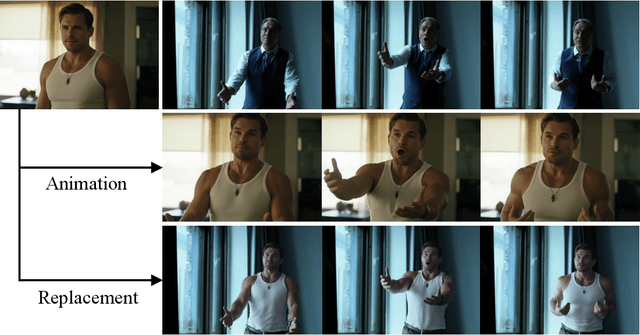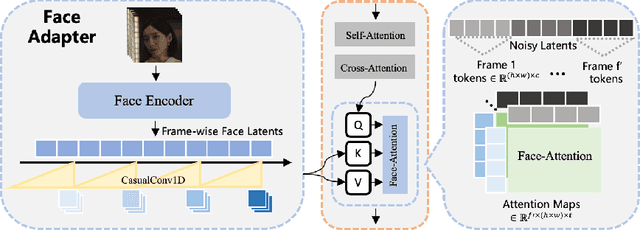Feng Wang
Seedance 1.5 pro: A Native Audio-Visual Joint Generation Foundation Model
Dec 23, 2025Abstract:Recent strides in video generation have paved the way for unified audio-visual generation. In this work, we present Seedance 1.5 pro, a foundational model engineered specifically for native, joint audio-video generation. Leveraging a dual-branch Diffusion Transformer architecture, the model integrates a cross-modal joint module with a specialized multi-stage data pipeline, achieving exceptional audio-visual synchronization and superior generation quality. To ensure practical utility, we implement meticulous post-training optimizations, including Supervised Fine-Tuning (SFT) on high-quality datasets and Reinforcement Learning from Human Feedback (RLHF) with multi-dimensional reward models. Furthermore, we introduce an acceleration framework that boosts inference speed by over 10X. Seedance 1.5 pro distinguishes itself through precise multilingual and dialect lip-syncing, dynamic cinematic camera control, and enhanced narrative coherence, positioning it as a robust engine for professional-grade content creation. Seedance 1.5 pro is now accessible on Volcano Engine at https://console.volcengine.com/ark/region:ark+cn-beijing/experience/vision?type=GenVideo.
Unlocking Dynamic Inter-Client Spatial Dependencies: A Federated Spatio-Temporal Graph Learning Method for Traffic Flow Forecasting
Nov 13, 2025Abstract:Spatio-temporal graphs are powerful tools for modeling complex dependencies in traffic time series. However, the distributed nature of real-world traffic data across multiple stakeholders poses significant challenges in modeling and reconstructing inter-client spatial dependencies while adhering to data locality constraints. Existing methods primarily address static dependencies, overlooking their dynamic nature and resulting in suboptimal performance. In response, we propose Federated Spatio-Temporal Graph with Dynamic Inter-Client Dependencies (FedSTGD), a framework designed to model and reconstruct dynamic inter-client spatial dependencies in federated learning. FedSTGD incorporates a federated nonlinear computation decomposition module to approximate complex graph operations. This is complemented by a graph node embedding augmentation module, which alleviates performance degradation arising from the decomposition. These modules are coordinated through a client-server collective learning protocol, which decomposes dynamic inter-client spatial dependency learning tasks into lightweight, parallelizable subtasks. Extensive experiments on four real-world datasets demonstrate that FedSTGD achieves superior performance over state-of-the-art baselines in terms of RMSE, MAE, and MAPE, approaching that of centralized baselines. Ablation studies confirm the contribution of each module in addressing dynamic inter-client spatial dependencies, while sensitivity analysis highlights the robustness of FedSTGD to variations in hyperparameters.
Kimi Linear: An Expressive, Efficient Attention Architecture
Oct 30, 2025Abstract:We introduce Kimi Linear, a hybrid linear attention architecture that, for the first time, outperforms full attention under fair comparisons across various scenarios -- including short-context, long-context, and reinforcement learning (RL) scaling regimes. At its core lies Kimi Delta Attention (KDA), an expressive linear attention module that extends Gated DeltaNet with a finer-grained gating mechanism, enabling more effective use of limited finite-state RNN memory. Our bespoke chunkwise algorithm achieves high hardware efficiency through a specialized variant of the Diagonal-Plus-Low-Rank (DPLR) transition matrices, which substantially reduces computation compared to the general DPLR formulation while remaining more consistent with the classical delta rule. We pretrain a Kimi Linear model with 3B activated parameters and 48B total parameters, based on a layerwise hybrid of KDA and Multi-Head Latent Attention (MLA). Our experiments show that with an identical training recipe, Kimi Linear outperforms full MLA with a sizeable margin across all evaluated tasks, while reducing KV cache usage by up to 75% and achieving up to 6 times decoding throughput for a 1M context. These results demonstrate that Kimi Linear can be a drop-in replacement for full attention architectures with superior performance and efficiency, including tasks with longer input and output lengths. To support further research, we open-source the KDA kernel and vLLM implementations, and release the pre-trained and instruction-tuned model checkpoints.
Wan-Animate: Unified Character Animation and Replacement with Holistic Replication
Sep 17, 2025



Abstract:We introduce Wan-Animate, a unified framework for character animation and replacement. Given a character image and a reference video, Wan-Animate can animate the character by precisely replicating the expressions and movements of the character in the video to generate high-fidelity character videos. Alternatively, it can integrate the animated character into the reference video to replace the original character, replicating the scene's lighting and color tone to achieve seamless environmental integration. Wan-Animate is built upon the Wan model. To adapt it for character animation tasks, we employ a modified input paradigm to differentiate between reference conditions and regions for generation. This design unifies multiple tasks into a common symbolic representation. We use spatially-aligned skeleton signals to replicate body motion and implicit facial features extracted from source images to reenact expressions, enabling the generation of character videos with high controllability and expressiveness. Furthermore, to enhance environmental integration during character replacement, we develop an auxiliary Relighting LoRA. This module preserves the character's appearance consistency while applying the appropriate environmental lighting and color tone. Experimental results demonstrate that Wan-Animate achieves state-of-the-art performance. We are committed to open-sourcing the model weights and its source code.
RadGS-Reg: Registering Spine CT with Biplanar X-rays via Joint 3D Radiative Gaussians Reconstruction and 3D/3D Registration
Aug 28, 2025Abstract:Computed Tomography (CT)/X-ray registration in image-guided navigation remains challenging because of its stringent requirements for high accuracy and real-time performance. Traditional "render and compare" methods, relying on iterative projection and comparison, suffer from spatial information loss and domain gap. 3D reconstruction from biplanar X-rays supplements spatial and shape information for 2D/3D registration, but current methods are limited by dense-view requirements and struggles with noisy X-rays. To address these limitations, we introduce RadGS-Reg, a novel framework for vertebral-level CT/X-ray registration through joint 3D Radiative Gaussians (RadGS) reconstruction and 3D/3D registration. Specifically, our biplanar X-rays vertebral RadGS reconstruction module explores learning-based RadGS reconstruction method with a Counterfactual Attention Learning (CAL) mechanism, focusing on vertebral regions in noisy X-rays. Additionally, a patient-specific pre-training strategy progressively adapts the RadGS-Reg from simulated to real data while simultaneously learning vertebral shape prior knowledge. Experiments on in-house datasets demonstrate the state-of-the-art performance for both tasks, surpassing existing methods. The code is available at: https://github.com/shenao1995/RadGS_Reg.
Kimi K2: Open Agentic Intelligence
Jul 28, 2025



Abstract:We introduce Kimi K2, a Mixture-of-Experts (MoE) large language model with 32 billion activated parameters and 1 trillion total parameters. We propose the MuonClip optimizer, which improves upon Muon with a novel QK-clip technique to address training instability while enjoying the advanced token efficiency of Muon. Based on MuonClip, K2 was pre-trained on 15.5 trillion tokens with zero loss spike. During post-training, K2 undergoes a multi-stage post-training process, highlighted by a large-scale agentic data synthesis pipeline and a joint reinforcement learning (RL) stage, where the model improves its capabilities through interactions with real and synthetic environments. Kimi K2 achieves state-of-the-art performance among open-source non-thinking models, with strengths in agentic capabilities. Notably, K2 obtains 66.1 on Tau2-Bench, 76.5 on ACEBench (En), 65.8 on SWE-Bench Verified, and 47.3 on SWE-Bench Multilingual -- surpassing most open and closed-sourced baselines in non-thinking settings. It also exhibits strong capabilities in coding, mathematics, and reasoning tasks, with a score of 53.7 on LiveCodeBench v6, 49.5 on AIME 2025, 75.1 on GPQA-Diamond, and 27.1 on OJBench, all without extended thinking. These results position Kimi K2 as one of the most capable open-source large language models to date, particularly in software engineering and agentic tasks. We release our base and post-trained model checkpoints to facilitate future research and applications of agentic intelligence.
AnimeColor: Reference-based Animation Colorization with Diffusion Transformers
Jul 27, 2025Abstract:Animation colorization plays a vital role in animation production, yet existing methods struggle to achieve color accuracy and temporal consistency. To address these challenges, we propose \textbf{AnimeColor}, a novel reference-based animation colorization framework leveraging Diffusion Transformers (DiT). Our approach integrates sketch sequences into a DiT-based video diffusion model, enabling sketch-controlled animation generation. We introduce two key components: a High-level Color Extractor (HCE) to capture semantic color information and a Low-level Color Guider (LCG) to extract fine-grained color details from reference images. These components work synergistically to guide the video diffusion process. Additionally, we employ a multi-stage training strategy to maximize the utilization of reference image color information. Extensive experiments demonstrate that AnimeColor outperforms existing methods in color accuracy, sketch alignment, temporal consistency, and visual quality. Our framework not only advances the state of the art in animation colorization but also provides a practical solution for industrial applications. The code will be made publicly available at \href{https://github.com/IamCreateAI/AnimeColor}{https://github.com/IamCreateAI/AnimeColor}.
StepHint: Multi-level Stepwise Hints Enhance Reinforcement Learning to Reason
Jul 03, 2025Abstract:Reinforcement learning with verifiable rewards (RLVR) is a promising approach for improving the complex reasoning abilities of large language models (LLMs). However, current RLVR methods face two significant challenges: the near-miss reward problem, where a small mistake can invalidate an otherwise correct reasoning process, greatly hindering training efficiency; and exploration stagnation, where models tend to focus on solutions within their ``comfort zone,'' lacking the motivation to explore potentially more effective alternatives. To address these challenges, we propose StepHint, a novel RLVR algorithm that utilizes multi-level stepwise hints to help models explore the solution space more effectively. StepHint generates valid reasoning chains from stronger models and partitions these chains into reasoning steps using our proposed adaptive partitioning method. The initial few steps are used as hints, and simultaneously, multiple-level hints (each comprising a different number of steps) are provided to the model. This approach directs the model's exploration toward a promising solution subspace while preserving its flexibility for independent exploration. By providing hints, StepHint mitigates the near-miss reward problem, thereby improving training efficiency. Additionally, the external reasoning pathways help the model develop better reasoning abilities, enabling it to move beyond its ``comfort zone'' and mitigate exploration stagnation. StepHint outperforms competitive RLVR enhancement methods across six mathematical benchmarks, while also demonstrating superior generalization and excelling over baselines on out-of-domain benchmarks.
Constellation as a Service: Tailored Connectivity Management in Direct-Satellite-to-Device Networks
Jul 01, 2025Abstract:Direct-satellite-to-device (DS2D) communication is emerging as a promising solution for global mobile service extension, leveraging the deployment of satellite constellations. However, the challenge of managing DS2D connectivity for multi-constellations becomes outstanding, including high interference and frequent handovers caused by multi-coverage overlap and rapid satellite movement. Moreover, existing approaches primarily operate within single-constellation shell, which inherently limits the ability to exploit the vast potential of multi-constellation connectivity provision, resulting in suboptimal DS2D service performances. To address these challenges, this article proposes a Constellation as a Service (CaaS) framework, which treats the entire multi-constellation infrastructure as a shared resource pool and dynamically forms optimal sub-constellations (SCs) for each DS2D service region. The formation of each SC integrates satellites from various orbits to provide tailored connectivity based on user demands, guided by two innovative strategies: predictive satellite beamforming using generative artificial intelligence (GenAI) and pre-configured handover path for efficient satellite access and mobility management. Simulation results demonstrate that CaaS significantly improves satellite service rates while reducing handover overhead, making it an efficient and continuable solution for managing DS2D connectivity in multi-constellation environments.
MagCache: Fast Video Generation with Magnitude-Aware Cache
Jun 10, 2025Abstract:Existing acceleration techniques for video diffusion models often rely on uniform heuristics or time-embedding variants to skip timesteps and reuse cached features. These approaches typically require extensive calibration with curated prompts and risk inconsistent outputs due to prompt-specific overfitting. In this paper, we introduce a novel and robust discovery: a unified magnitude law observed across different models and prompts. Specifically, the magnitude ratio of successive residual outputs decreases monotonically and steadily in most timesteps while rapidly in the last several steps. Leveraging this insight, we introduce a Magnitude-aware Cache (MagCache) that adaptively skips unimportant timesteps using an error modeling mechanism and adaptive caching strategy. Unlike existing methods requiring dozens of curated samples for calibration, MagCache only requires a single sample for calibration. Experimental results show that MagCache achieves 2.1x and 2.68x speedups on Open-Sora and Wan 2.1, respectively, while preserving superior visual fidelity. It significantly outperforms existing methods in LPIPS, SSIM, and PSNR, under comparable computational budgets.
 Add to Chrome
Add to Chrome Add to Firefox
Add to Firefox Add to Edge
Add to Edge